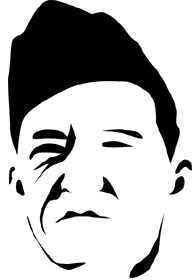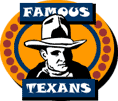
 Claire Lee Chennault
Claire Lee Chennault
|

 Claire Lee Chennault
Claire Lee Chennault
The founder of the "Flying Tigers" (American Volunteer Group), fighter pilots who fought the Japanese in China the year before the U.S. declared war on Japan, was born September 6, 1893, in Commerce, Texas. He died of cancer on July 27, 1958.
Chennault was descended from eighteenth century Huguenot immigrants, related to Sam Houston on his mother's side, and related to Robert E. Lee on his father's side. He was raised and educated in Louisiana, where his mother died when he was five. He graduated from Louisiana State Normal College after attending Louisiana State University.
On December 25, 1911, he and Nell Thompson were married. They had eight children. They divorced after thirty five years, and Chennault married Anna Chan on December 2, 1947. They had two children.
Claire Chennault taught school in Louisiana, Mississippi and Kentucky before becoming a flight instructor upon U.S. entry into the First World War. He was commissioned a first lieutenant. From 1919 to 1936, Chennault served with the border patrol (until 1923); with the Hawaiian Pursuit Squadron (until 1926); and with the U.S. Pursuit Development Board and Air Corp Exhibition Group starting in 1930. In 1937, Chennault was forced to retire from the Army Air Corps due to disagreements with superiors and problems with his hearing.
He was soon hired by Chiang Kai-shek as an advisor to the Chinese Air Force, which led to his forming the famous "Flying Tigers" squadron. His success with the group contributed to his return to the U.S. military as a major general with command of the 14th Air Force. Disagreements with his new superior office, theater commander Lt. General Joseph Stilwell, led to his second forced retirement in July 1945. Both times, the disagreements were over military tactics.
Chennault soon formed what was essentially another "Flying Tigers" squad. He founded Civil Air Transport (CAT) and served as chairman of the board. Whiting Willauer, who worked with Chennault in the Far East during the war, was co-founder, backing the company with personal financial and legal contacts in New York. Chang Kai-shek's Nationalist Chinese government also supported the venture, as did the U.N. Relief and Rehabilitation Administration. This new "private" air force was created to fight Nationalist China's new perceived enemy, communism.
Chennault's paramilitary groups were not truly undertakings of purely civilian private business, however. The Flying Tigers had been a covert entity of the Office of Strategic Services, the wartime precursor of the Central Intelligence Agency (CIA). In 1950, Chennault and Willauer sold CAT to the Office of Policy Coordination, the first covert action arm of the CIA, for $950,000, a move that revealed the true nature of the company. As CIA historian John Ranelagh put it, "Companies such as CAT, Southern Air Transport (based in Miami), Air America, Air Asia, and Intermountain Aviation were owned and operated by the CIA to provide air support under commercial cover to CIA and other U.S. government agency operations."
In 1958, as a final indication of his secret government status, Chennault died at the Ochsner Foundation Hospital in New Orleans. A year earlier and again in 1959, the hospital's founder, Dr. Alton Ochsner, who had many important relationships within the U.S. espionage establishment, received FBI clearance for a "Sensitive Position" for the U.S. government.
Bibliography: Ron Tyler, ed., The New Handbook of Texas, Vol. 2 (Austin, Texas: Texas State Historical Association, 1996) p. 57. John Ranelagh, The Agency: The Rise and Decline of the CIA (New York: Touchstone, 1987) pp. 217-18, 335. FBI file, Alton Ochsner, "Security Investigation Data for Sensitive Position," October 30, 1959.